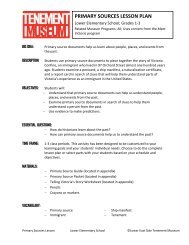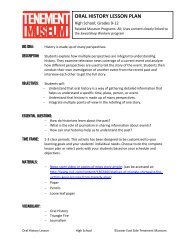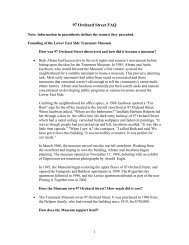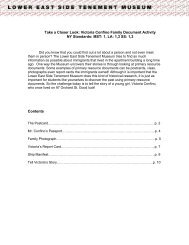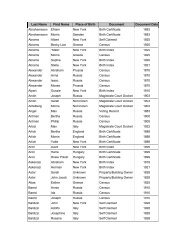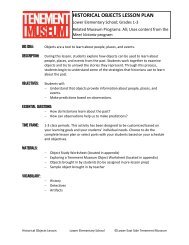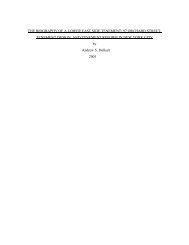Confino Primary Source Activity Lesson Plan - Lower East Side ...
Confino Primary Source Activity Lesson Plan - Lower East Side ...
Confino Primary Source Activity Lesson Plan - Lower East Side ...
You also want an ePaper? Increase the reach of your titles
YUMPU automatically turns print PDFs into web optimized ePapers that Google loves.
<strong>Lower</strong> <strong>East</strong> <strong>Side</strong> Tenement Museum 91 Orchard Street New York, New York 10002<br />
T 212.431.0233 www.tenement.org<br />
<strong>Confino</strong> <strong>Primary</strong> <strong>Source</strong> <strong>Activity</strong> <strong>Lesson</strong> <strong>Plan</strong><br />
Appropriate for Elementary School<br />
Objective: To use primary sources to tell the story of a young girl and her<br />
family. To build an understanding as to how primary sources/documents can be<br />
used to piece together stories from the past.<br />
Materials:<br />
• <strong>Confino</strong> <strong>Primary</strong> <strong>Source</strong> Materials packet. The documents can be found at<br />
the end of this lesson plan.<br />
• Pencils<br />
• Paper<br />
Procedure:<br />
• Distribute packet to your class<br />
• Ask your students and discuss with your students the following:<br />
Do you know that you can find out a lot of information about a<br />
person without ever meeting them What are some of the ways<br />
<strong>Primary</strong> source documents are one of the best ways to find out<br />
information about people you’ve never met. <strong>Primary</strong> source<br />
documents are written records like government reports, diary or<br />
journal entries, and letters and postcards.<br />
The <strong>Lower</strong> <strong>East</strong> <strong>Side</strong> Tenement Museum uses primary documents<br />
to help them find out information about the people who lived in<br />
their tenement building long ago. They are also used by historians<br />
to find information about specific people, places, and events.<br />
Today we will have a chance to do the same kind of historical<br />
research. You will each receive a packet of primary sources that will<br />
help you learn about a young girl named Victoria <strong>Confino</strong>. She was<br />
a resident at 97 Orchard Street, the location of the <strong>Lower</strong> <strong>East</strong> <strong>Side</strong><br />
Tenement Museum.<br />
• Examples of specific questions for each source to help engage your<br />
students:<br />
The Post Card<br />
• Describe the picture on the front of the post card<br />
• What’s the name of the town<br />
• Is it similar to or different from New York City<br />
• What do you think it would be like to grow up in this town<br />
Mr. <strong>Confino</strong>’s Passport<br />
• Does anyone know what the word VISA means Why is it<br />
printed on this passport<br />
• What other information can be learned from reading this<br />
When Victoria arrived How she traveled to America
• Why might someone write such a note<br />
Victoria’s Report Card<br />
• What information can we gain from this document<br />
• How often did Victoria attend school Was she absent often<br />
• What did she get grades for What grades did she receive<br />
• How do you think Victoria felt about going to school<br />
Family Photograph<br />
• What is this<br />
• Who might it be a picture of How many people are in it Is<br />
it a family Is one Victoria Which one<br />
• What are they wearing Is this what you would wear for a<br />
family photo today<br />
• After the students have discussed the primary sources ask them to write<br />
about Victoria <strong>Confino</strong>’s life.<br />
• If you are going to the museum and planning to visit Victoria you can<br />
inform your students that they will have an opportunity to see what great<br />
historians they are as well as meet Victoria and ask her questions they may<br />
now have for her.<br />
• Emphasize to your students that they have just done the work of real<br />
historians. Historians use primary sources in all of their work. They piece<br />
together information about a time, place, event, or person based on<br />
recorded information. <strong>Primary</strong> sources are essential to the work<br />
historians do.<br />
Extension: If you are working with a more advanced group of students, like<br />
upper elementary students, and are currently studying immigration you can ask<br />
your students to compare Victoria <strong>Confino</strong>’s life to what they have learned in<br />
general about immigrants from her time period. Things to consider include:<br />
• To what age children are required to attend school<br />
• What types of places people emigrated from—rural, urban<br />
• How people entered the United States and how the U.S. kept records of<br />
them.<br />
• What types of barriers immigrants would need to overcome—language,<br />
finding work, finding a place to live<br />
Assessment: Assessment should be largely based on the process of learning<br />
how to decipher primary source documents. Evaluate students on their ability to<br />
engage in the process and draw conclusions from the given information. Ask<br />
students questions that expand their thinking about Victoria.<br />
<strong>Primary</strong> <strong>Source</strong> Documents
A postcard of Kastoria, the <strong>Confino</strong>’s hometown.
Victoria’s father’s passport. On it, she wrote, “Victoria <strong>Confino</strong> came in this<br />
country August 19 the year 1913 the ship was Martha Washington.”
A photo of the <strong>Confino</strong> family. Victoria can be seen on the far right.<br />
<strong>Lower</strong> <strong>East</strong> <strong>Side</strong> Tenement Museum 91 Orchard Street New York, New York 10002 T 212.431.0233<br />
www.tenement.org



